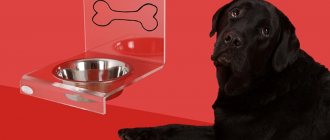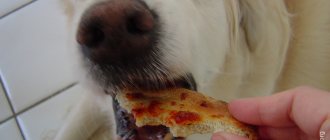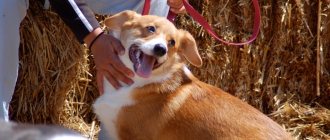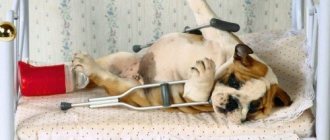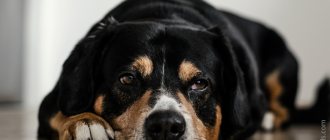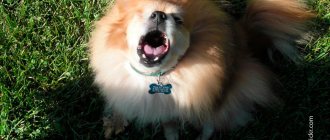Many dog owners are familiar with the situation when the animal refuses to eat. Why is this happening? What to do and how to help your four-legged friend? First of all, remember that your dog eats not because it tastes good, but to replenish his daily supply of essential nutrients. If this does not happen, you should observe the dog and figure out what happened to it and whether there are any symptoms of the disease.
| Calling a veterinarian to your home | For free |
Physiological reasons for a dog's refusal to eat
Worms
The reason is quite common. In addition to loss of appetite, lethargy, vomiting and diarrhea may occur. The dog's coat becomes dull and rough.
Treatment with antiparasitic drugs is necessary.
Poisoning or intestinal infection
Along with loss of appetite, alarming symptoms such as vomiting or diarrhea appear.
In case of poisoning, immediate medical attention may be required.
Problem with teeth
A dog refuses to eat due to dental diseases such as tartar, caries, periodontitis, and stomatitis. Clean plaque regularly, otherwise it will grow and cause gum inflammation or contribute to the development of tooth decay.
If you cannot do this regularly and efficiently, contact a veterinarian who will use a special tool.
Serious health problems
At an early stage, it is difficult to identify heart and pulmonary diseases, problems with the thyroid gland, and cancer. Loss of appetite in such cases is only one of the signs of a serious illness.
Therefore, it is necessary to contact the clinic and conduct additional examination.
New food
Problems with food can lead to loss of appetite, so you need to find out whether the animal refuses any food or only a certain product. If your dog has always eaten only natural food, he may not like dry food. Such food may seem strange and unusual to the dog. Therefore, you need to gradually transfer the animal to dry food over several weeks. Appetite problems may arise if you change the brand of dry food or store it for a long time. Opened packaging should be used within a month.
Monitor your dog's diet. Too frequent feedings and large portions can lead to overfeeding and loss of appetite. In this case, reduce the number of feedings to twice a day and reduce the portions.
Causes of pulmonary failure
Any disturbance in the functioning of one or more respiratory organs (for example, the respiratory tract or lungs) can lead to the development of respiratory failure in a cat or dog, which poses a direct threat to the health and life of the animal.
Respiratory failure occurs when the level of oxygen in the blood becomes too low (hypoxemic form) and when the level of carbon dioxide in the blood becomes too high (hypercapnic form).
Important! The causes of hypoxemic (pulmonary) and hypercapnic (ventilatory) forms of respiratory failure in dogs and cats differ.
Causes of hypercapnic (ventilation) form of respiratory failure:
- Violation of central regulation of breathing (control of respiratory muscles). Such disorders occur with arterial hypotension (low blood pressure), as well as with pathological processes occurring in the central nervous system (for example, meningoencephalitis), traumatic brain injury and poisoning with drugs that suppress the functioning of the respiratory center.
- Neuromuscular disorders. The main feature of such diseases is muscle weakness. Respiratory failure in cats and dogs can occur against the background of myopathy (chronic progressive neuromuscular diseases), as well as ruptures or unilateral persistent high position of the diaphragm, accompanied by damage to the phrenic nerve in animals.
- Damage to the chest and pleural cavity. The causes of respiratory failure in dogs and cats can be pneumothorax (accumulation of air or gases in the pleural cavity), floating rib fractures, neoplasms (malignant and benign tumors), as well as foreign objects trapped in the chest, and even metastatic pleurisy (inflammation of the pleura) .
- Airway obstruction. Respiratory failure in dogs and cats can be caused by bronchial asthma, laryngeal edema, as well as narrowing of the lumen of small bronchi and bronchioles (bronchospasm). These diseases impair the animal's airways, which can lead to the development of respiratory failure.
Causes of hypoxemic (pulmonary) respiratory failure, when the oxygen level in an animal's blood becomes too low, include pneumonia, acute respiratory distress syndrome, pulmonary edema, as well as lung injury in cats and dogs, pulmonary fibrosis, and pulmonary thromboembolism.
Psychological reasons for a dog's refusal to eat
If all of the above problems are excluded, refusal to eat may be associated with the emotional state of your four-legged friend.
- Depression. A dog can become depressed for various reasons: a long absence of the owner, separation from a friend (another dog), moving and getting used to a new place of residence. The animal becomes apathetic and withdrawn, does not greet the owner at the door, and sleeps for a long time somewhere in the corner. The most alarming sign is loss of appetite.
- As a rule, the cause of stress in a dog is fear. It can be caused by threats from other animals, abuse, unusual circumstances (traveling in a car, getting a haircut), medical procedures, etc.
It is necessary to figure out what caused the depression or stress and try to help the dog. Pay more attention to her, talk affectionately, stroke her, walk her more often. In severe cases, you can use sedatives prescribed by your veterinarian.
Diagnostics
Your veterinarian will perform a thorough physical examination of your dog and may also recommend blood tests, urine tests, x-rays, organ tests, and endoscopy.
Biochemical organ testing can evaluate the functioning of vital organs such as the liver and kidneys.
It is advisable to perform these tests on your dog because any endocrine abnormalities associated with insulin dysfunction will also be identified if present.
Abnormally low blood sugar levels, known as hypoglycemia, may also be found and may be associated with some forms of insulin-producing tumors that can affect the functioning of the pancreas.
A blood test will allow your veterinarian to examine the blood for the presence of infectious agents and will also show whether your pet has anemia (low levels of iron in the blood) or vascular inflammation.
The absence of these conditions may indicate whether the increased appetite is caused by a behavioral problem or a physical problem.
Your veterinarian may suggest a urine test to evaluate whether your pet is losing excessive amounts of protein in the urine.
A urine test will also show a urinary tract infection, or infection of organs involved in the waste elimination process, as well as sugar in the urine, which is commonly found in the urine of dogs with diabetes.
Your doctor may also want to do an examination using endoscopy, which uses a tube that is inserted through the mouth into the cavity of the stomach (or other organ) so that a tissue sample (biopsy) can be taken from the stomach. and duodenum (small intestine).
When is a dog's poor appetite considered normal?
A dog's lack of appetite does not always mean something bad has happened. There are understandable reasons for an animal’s refusal to eat.
- Heat. Just like people, dogs refuse to eat in hot weather. As a rule, when the temperature outside decreases, appetite is restored. Don't forget to offer your dog water.
- Changes in hormonal levels. A dog may refuse to eat during estrus, pregnancy, or the day before giving birth.
- Teething in puppies. The food requirements of growing puppies fluctuate constantly. During teething, appetite often decreases. To solve the problem, it is recommended to replace dry food with cool and soft food.
- Aging. Older dogs often lose their appetite. Therefore, their food should be soft and balanced. Low-calorie, low-protein foods are recommended.
- Caprice. A dog can be picky and refuse a certain type of food, begging for a treat in this way. Don't follow her lead. However, take a closer look at your pet’s behavior, maybe something is bothering him. If, in addition to lack of appetite, you notice fever, drowsiness, or indigestion, consult a veterinarian.
Appetite boosters
If the above recommendations do not give the desired effect, the following will help stimulate your dog’s appetite:
- appetite stimulants;
- bitterness;
- decoctions, tinctures of medicinal plants;
- essential oils (apply a few drops to the collar);
- nutritional supplements;
- preprobiotics, enzymes;
- homeopathy remedies;
- a gentle diet with minimal fat;
- vitamin and mineral complexes.
Among the natural herbs you can brew for your dog are ginger, chamomile, clover flowers, dandelion, dill, garlic, celery, peppermint, and wormwood. Natural raw materials are prepared according to the instructions. Pour 1-2 tbsp into the dog’s mouth about 30-40 minutes before meals. spoons.
Dry, powdered herbs are added to food. But keep in mind that it is not the aroma of herbs that can scare away the dog.
Important! Healing plants containing bitterness should not be given to dogs with gastritis, erosive lesions, other pathologies of the gastrointestinal tract, or individual intolerance.
Flax seed, rice water, low-fat broth with vegetables, minimal sodium content, baby food are also recommended by veterinarians to normalize appetite in pets. Natural honey helps some dogs restore their appetite.
How to increase a dog's appetite?
If the animal does not look sick, try to deal with the problem yourself. What can you do if your dog refuses to eat?
- Increase your physical activity and go for walks more often. Sometimes dogs lose their appetite due to lack of exercise. Pets that are rarely walked do not have the opportunity to waste energy.
- Do not feed for 24 hours or skip at least one feeding. Offer familiar food and do not indulge your dog with treats. Don't try to persuade her, just skip feeding.
- Diversify your diet, try new foods. Change the grain, offer fish instead of meat, try a different brand of dry food.
- Warm up your food. Sometimes a dog eats warm food more willingly.
- Reduce your portions. The amount of food depends on many factors: breed, age, condition, level of physical activity. If you lose your appetite, reduce your usual portion by 10%.
What is this?
Respiratory failure (RF) in dogs and cats is a pathological condition in which the animal’s lungs do not provide normal blood gas composition or do, but it is achieved due to the intensive work of the external respiratory apparatus and heart, which reduces the functional characteristics of the body.
Important! Pulmonary insufficiency in cats and dogs is dangerous because without timely treatment it leads to acute and chronic diseases of the bronchopulmonary system, circulatory disorders, damage to the central nervous system and a number of other dangerous complications.
What to do if the dog doesn't eat?
Seeking professional veterinary help would be the right decision if:
- The dog does not eat for more than two days, the puppy for more than a day
- The animal is unable to swallow
- The dog refuses all types of food and water
- There is vomiting, diarrhea, fever, pain and other alarming symptoms
Your pet may need additional testing:
- Blood analysis
- Abdominal ultrasound
- X-ray
- Hormone test
What food is best for capricious dogs?
For animals of the order of predators, such as dogs, it is the meat aroma that is primarily attracted to food, so the more meat there is in the food, the more desirable it will be for picky dogs.
Acana Dog and Orijen Dog contain 50-85% animal derived ingredients. In addition, most of our formulas include carefully processed freeze-dried liver, a natural flavor and aroma enhancer that makes the food a real delicacy for even the most capricious animals.
In addition, other picky dogs that refuse almost all foods containing lamb and poultry like diets with fish. They are also presented in our assortment, for example:
- Orijen Six Fish - 85% animal-based, containing 6 varieties of fresh, whole, wild-caught fish from the Vancouver Island area;
- Acana Pacific Pilchard is a mono-protein product for dogs with food allergies and intolerances. Contains only one source of animal protein and fat - wild-caught ocean sardine;
- Acana Pacifica - 70% high quality fish ingredients, including wild perch, wild herring, flounder and silver hake;
- Acana Wild Coast is a diet from the Classic line, 50% consists of dehydrated and fresh fish of noble varieties.
Recovery
Be sure to carefully follow your veterinarian's instructions for resuming feeding and diet. The gastrointestinal tract is often sensitive after periods of not eating, and your veterinarian's dietary instructions will help you manage this problem. Notify your veterinarian if appetite does not improve significantly within 1-2 days after release, and closely monitor bowel movements and behavior.
Recovery from anorexia depends on the ability to quickly identify and treat the root cause. The prognosis is usually good if caught early, and dogs may regain their appetite within a day or two after the underlying cause is treated.
Symptoms and signs of underweight
Body weight is closely related to overall well-being. A normal weight dog is active and playful. Her waist begins just behind her lower ribs and is clearly visible when viewed from above. Also, a healthy animal has a tucked belly and imperceptible, but palpable ribs. They must be covered with a small layer of subcutaneous fat.
With exhaustion or obesity, metabolism is disrupted and there is a high likelihood of developing arthritis. If you notice behavioral changes, carefully examine your pet. Depending on external symptoms, there are 4 deviations from normal weight:
- Obesity
. The dog has massive fat deposits on the chest, lower back and base of the tail. There is no waist. - Overweight
. The transition to the waist is almost lost. Fatty deposits are visible on the lower back and at the base of the tail. The ribs are difficult to palpate, as they are covered with a thick layer of fat. - Underweight
. The transition to the waist is sharply defined. The pelvic bones and lumbar vertebrae are visible. When palpating the ribs, subcutaneous fat is not felt. - Dystrophy
. Loss of muscle mass and lack of fat reserves are obvious. Protruding bones are clearly visible from the side.
In the first two cases, the dog is put on a diet and physical activity is increased. Despite popular belief, gaining pounds is much more difficult than losing it. To gain not only fat, but also muscle mass, you will have to work hard - both the owner and the dog itself.
When to start getting nervous
A decrease in activity may indicate that the appetite has disappeared due to health problems.
If your pet dog does not eat for several days, but at the same time feels well and remains in a normal mood, there is no need to worry. However, if your dog has lost his appetite and is exhibiting other symptoms, he will need help from a veterinarian.
Symptoms to watch out for include the following:
- fever;
- shiver;
- vomit;
- mucus in stool;
- refusal to drink water;
- decreased activity;
- increased anxiety;
- lethargy.
Additional Information! When loss of appetite is accompanied by vomiting of bile, there is no need to panic. This happens due to prolonged fasting.
